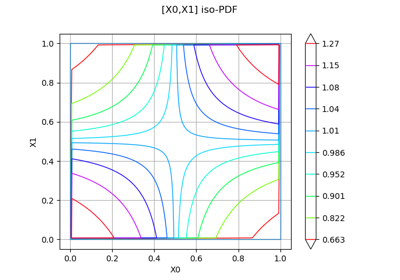BernsteinCopulaFactory¶
- class BernsteinCopulaFactory(*args)¶
BernsteinCopula copula factory.
See also
Notes
This class provides a non parametric estimator of a copula: the
EmpiricalBernsteinCopula.Methods
ComputeAMISEBinNumber(sample)Compute the optimal AMISE number of bins.
Compute the optimal log-likelihood number of bins by cross-validation.
Compute the optimal penalized Csiszar divergence number of bins.
build(*args)Build the nonparametric Bernstein copula estimator based on the empirical copula.
Build the nonparametric Bernstein copula estimator based on the empirical copula.
buildEstimator(*args)Build the distribution and the parameter distribution.
Accessor to the bootstrap size.
Accessor to the object's name.
getName()Accessor to the object's name.
hasName()Test if the object is named.
setBootstrapSize(bootstrapSize)Accessor to the bootstrap size.
setName(name)Accessor to the object's name.
- __init__(*args)¶
- static ComputeAMISEBinNumber(sample)¶
Compute the optimal AMISE number of bins.
- Parameters:
- sample2-d sequence of float, of dimension 1
The sample from which the optimal AMISE bin number is computed.
Notes
The number of bins is computed by minimizing the asymptotic mean integrated squared error (AMISE), leading to
where
is the largest integer less than or equal to
,
the sample size and
the sample dimension.
- static ComputeLogLikelihoodBinNumber(*args)¶
Compute the optimal log-likelihood number of bins by cross-validation.
- Parameters:
- sample2-d sequence of float, of dimension 1
The sample of size
from which the optimal log-likelihood bin number is computed.
- kFractionint,
The fraction of the sample used for the validation.
Notes
Let
be the given sample. If
, the bin number
is given by:
where
is the density function of the
EmpiricalBernsteinCopulaassociated to the sampleand the bin number
.
If
, the bin number
is given by:
where
and
- static ComputePenalizedCsiszarDivergenceBinNumber(*args)¶
Compute the optimal penalized Csiszar divergence number of bins.
- Parameters:
- sample2-d sequence of float, of dimension 1
The sample of size
from which the optimal AMISE bin number is computed.
- f
Function The function defining the Csiszar divergence of interest.
- alphafloat,
The penalization factor.
Notes
Let
be the given sample. The bin number
is given by:
where
is the density function of the
EmpiricalBernsteinCopulaassociated to the sampleand the bin number
,
a Monte Carlo estimate of the Csiszar
divergence,
the exact Spearman correlation of the empirical Bernstein copula
and
the empirical Spearman correlation of the sample
.
The parameter
is controlled by the ‘BernsteinCopulaFactory-SamplingSize’ key in
ResourceMap.
- build(*args)¶
Build the nonparametric Bernstein copula estimator based on the empirical copula.
Available usages:
build()
build(sample)
build(sample, method, objective)
build(sample, m)
- Parameters:
- sample2-d sequence of float, of dimension d
The sample of size
from which the copula is estimated.
- methodstr
The name of the bin number selection method. Possible choices are AMISE, LogLikelihood and PenalizedCsiszarDivergence. Default is LogLikelihood, given by the ‘BernsteinCopulaFactory-BinNumberSelection’ entry of
ResourceMap.- mint
The number of sub-intervals in which all the edges of the unit cube
are regularly partitioned.
- Returns:
- copula
Distribution The estimated copula as a generic distribution.
- copula
- buildAsEmpiricalBernsteinCopula(*args)¶
Build the nonparametric Bernstein copula estimator based on the empirical copula.
Available usages:
buildAsEmpiricalBernsteinCopula()
buildAsEmpiricalBernsteinCopula(sample)
buildAsEmpiricalBernsteinCopula(sample, method, objective)
buildAsEmpiricalBernsteinCopula(sample, m)
- Parameters:
- sample2-d sequence of float, of dimension d
The sample of size
from which the copula is estimated.
- methodstr
The name of the bin number selection method. Possible choices are AMISE, LogLikelihood and PenalizedCsiszarDivergence. Default is LogLikelihood, given by the ‘BernsteinCopulaFactory-BinNumberSelection’ entry of
ResourceMap.- mint
The number of sub-intervals in which all the edges of the unit cube
are regularly partitioned.
- Returns:
- copula
EmpiricalBernsteinCopula The estimated copula as an empirical Bernstein copula.
- copula
- buildEstimator(*args)¶
Build the distribution and the parameter distribution.
- Parameters:
- sample2-d sequence of float
Data.
- parameters
DistributionParameters Optional, the parametrization.
- Returns:
- resDist
DistributionFactoryResult The results.
- resDist
Notes
According to the way the native parameters of the distribution are estimated, the parameters distribution differs:
Moments method: the asymptotic parameters distribution is normal and estimated by Bootstrap on the initial data;
Maximum likelihood method with a regular model: the asymptotic parameters distribution is normal and its covariance matrix is the inverse Fisher information matrix;
Other methods: the asymptotic parameters distribution is estimated by Bootstrap on the initial data and kernel fitting (see
KernelSmoothing).
If another set of parameters is specified, the native parameters distribution is first estimated and the new distribution is determined from it:
if the native parameters distribution is normal and the transformation regular at the estimated parameters values: the asymptotic parameters distribution is normal and its covariance matrix determined from the inverse Fisher information matrix of the native parameters and the transformation;
in the other cases, the asymptotic parameters distribution is estimated by Bootstrap on the initial data and kernel fitting.
- getBootstrapSize()¶
Accessor to the bootstrap size.
- Returns:
- sizeint
Size of the bootstrap.
- getClassName()¶
Accessor to the object’s name.
- Returns:
- class_namestr
The object class name (object.__class__.__name__).
- getName()¶
Accessor to the object’s name.
- Returns:
- namestr
The name of the object.
- hasName()¶
Test if the object is named.
- Returns:
- hasNamebool
True if the name is not empty.
- setBootstrapSize(bootstrapSize)¶
Accessor to the bootstrap size.
- Parameters:
- sizeint
The size of the bootstrap.
- setName(name)¶
Accessor to the object’s name.
- Parameters:
- namestr
The name of the object.
 OpenTURNS
OpenTURNS
